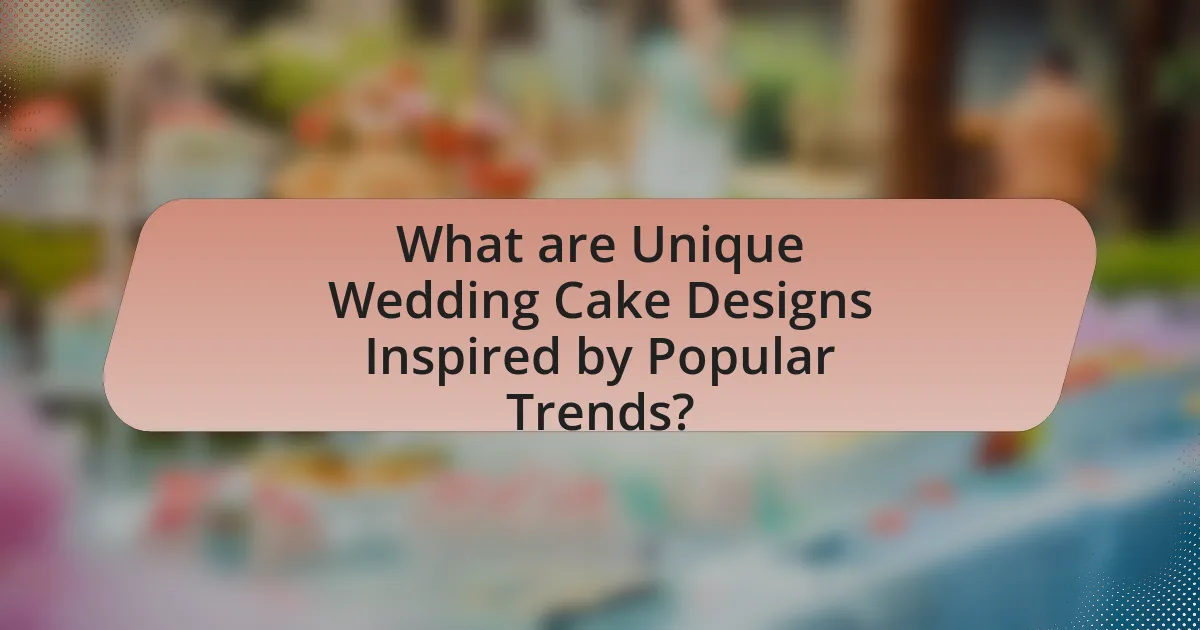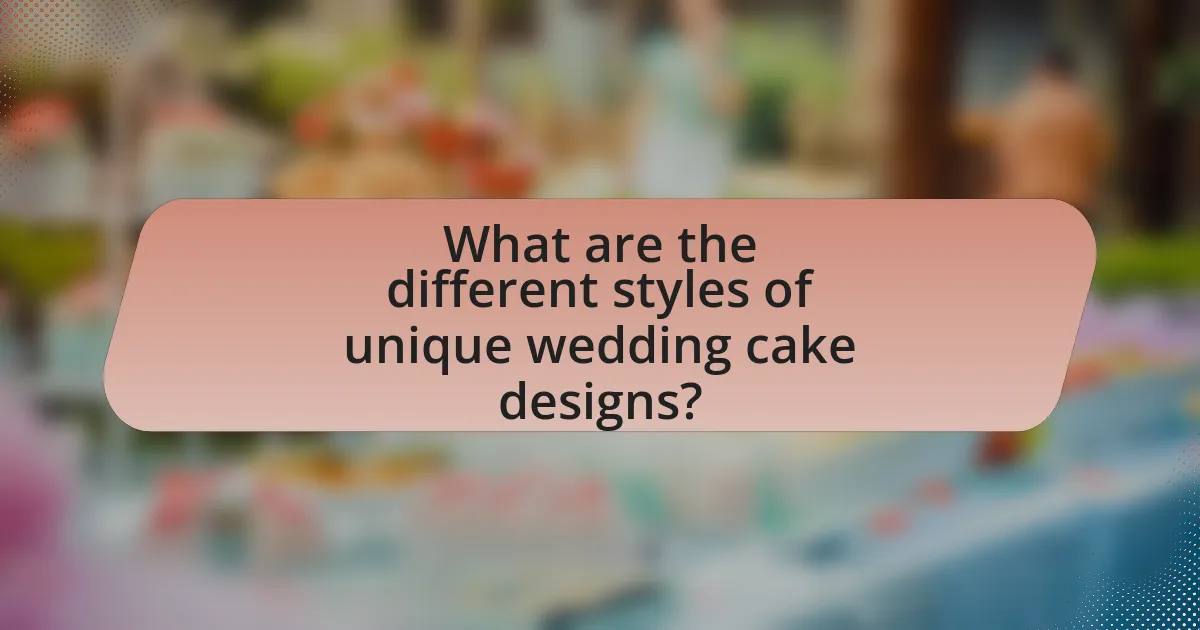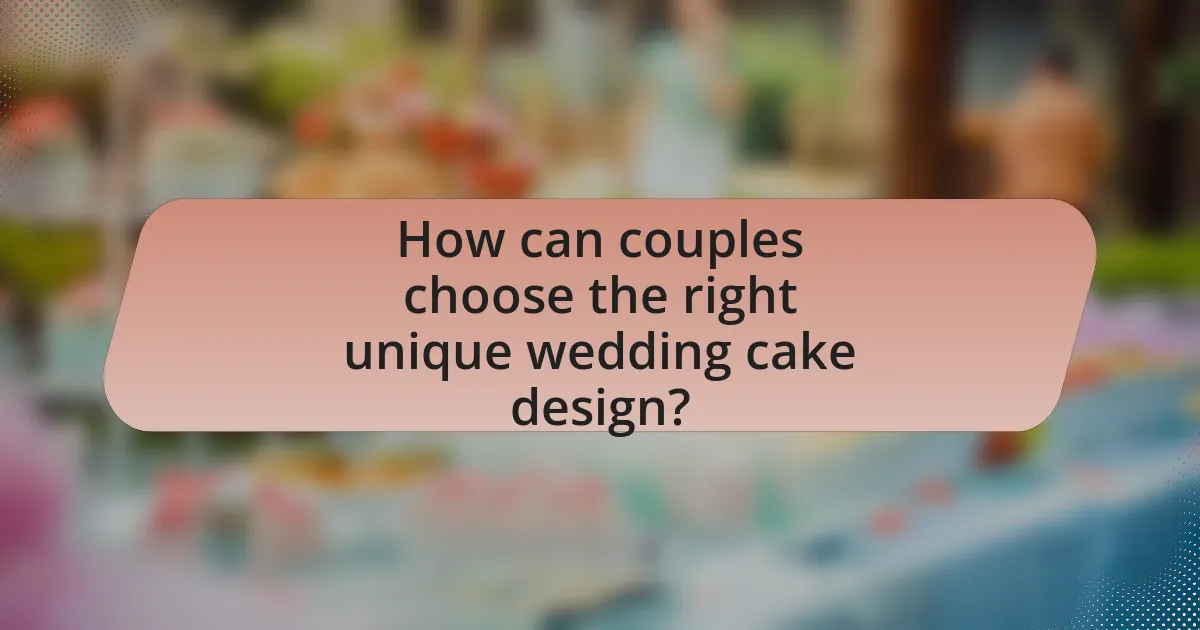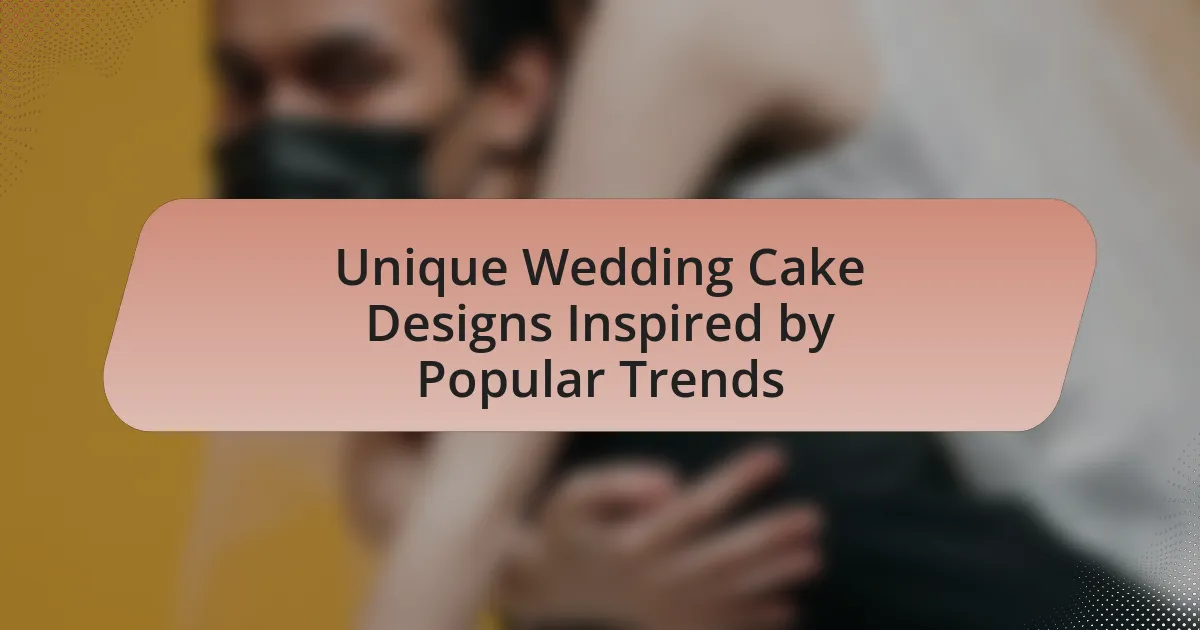Unique wedding cake designs inspired by popular trends encompass a variety of styles, including geometric shapes, watercolor effects, and floral arrangements. Current trends influence these designs by emphasizing personalization, unique flavors, and modern aesthetics, with couples increasingly opting for minimalist styles and bold colors. Cultural influences also play a significant role, shaping flavors and decorative elements that reflect heritage. The article explores the importance of unique designs for couples, the impact of personalization, and practical considerations for selecting the right cake, including budget and communication with cake designers. Additionally, it addresses common challenges in creating these cakes and offers best practices for ensuring a successful wedding cake experience.

What are Unique Wedding Cake Designs Inspired by Popular Trends?
Unique wedding cake designs inspired by popular trends include geometric shapes, watercolor effects, and floral arrangements. Geometric cakes often feature clean lines and bold colors, reflecting modern aesthetics. Watercolor cakes utilize soft, blended colors to create a dreamy effect, appealing to couples seeking artistic flair. Floral arrangements, whether realistic or abstract, add a natural touch, aligning with the trend of incorporating organic elements into wedding decor. These designs are validated by their increasing presence in wedding magazines and social media platforms, showcasing their popularity among contemporary couples.
How do current trends influence wedding cake designs?
Current trends significantly influence wedding cake designs by dictating flavors, aesthetics, and presentation styles. For instance, the rise of minimalist design has led to an increase in simple, elegant cakes featuring clean lines and subtle colors, reflecting a broader trend towards understated luxury in weddings. Additionally, the popularity of unique flavors, such as matcha or lavender, showcases a shift from traditional vanilla and chocolate, aligning with the trend of personalization and experiential dining. Furthermore, the use of natural elements, like fresh flowers and greenery, is on the rise, mirroring the trend towards eco-friendly and sustainable practices in event planning. These trends are supported by industry reports indicating that couples increasingly seek to reflect their personal tastes and values in their wedding choices, including cake designs.
What are the most popular trends in wedding cakes today?
The most popular trends in wedding cakes today include minimalist designs, bold colors, and unique flavor combinations. Minimalist cakes often feature clean lines and simple decorations, reflecting a modern aesthetic that emphasizes elegance. Bold colors, such as deep blues and vibrant greens, are increasingly favored, moving away from traditional white. Additionally, couples are opting for unique flavor combinations, such as lavender and lemon or chocolate and raspberry, to personalize their cakes. These trends are supported by data from wedding industry reports, which indicate a shift towards personalization and creativity in wedding cake design.
How do cultural influences shape wedding cake designs?
Cultural influences significantly shape wedding cake designs by dictating the flavors, colors, and decorative elements used. For instance, in many Western cultures, white wedding cakes symbolize purity and are often adorned with intricate fondant designs, while in Indian weddings, multi-tiered cakes may feature vibrant colors and flavors like cardamom or saffron, reflecting local traditions. Additionally, specific cultural symbols, such as cherry blossoms in Japanese weddings or sugar skulls in Mexican celebrations, are incorporated into cake designs to honor heritage and customs. This diversity in cake design illustrates how cultural backgrounds inform not only aesthetic choices but also the overall significance of the wedding cake in various ceremonies.
Why are unique wedding cake designs important for couples?
Unique wedding cake designs are important for couples because they serve as a personal expression of their individuality and relationship. These designs reflect the couple’s style, preferences, and the theme of their wedding, making the cake a focal point of the celebration. According to a survey by The Knot, 80% of couples consider their wedding cake to be a significant part of their wedding experience, emphasizing its role in creating memorable moments. Unique designs can also enhance the overall aesthetic of the wedding, contributing to the visual storytelling of the event.
What role does personalization play in wedding cake selection?
Personalization plays a crucial role in wedding cake selection by allowing couples to reflect their unique tastes and preferences in their cake design. This customization can include flavors, colors, and decorative elements that resonate with the couple’s story or wedding theme. According to a survey by The Knot, 75% of couples choose a cake that represents their personal style, highlighting the importance of individuality in this aspect of wedding planning. Personalization not only enhances the aesthetic appeal of the cake but also creates a memorable experience for the couple and their guests, making the cake a central part of the celebration.
How can unique designs reflect a couple’s story or theme?
Unique designs can reflect a couple’s story or theme by incorporating personal elements that symbolize their relationship, such as shared interests, significant dates, or cultural backgrounds. For instance, a cake design featuring elements like favorite colors, motifs from their first date, or symbols representing their heritage can create a narrative that resonates with their journey together. This approach not only personalizes the cake but also serves as a visual representation of their unique bond, making the cake a memorable centerpiece at their wedding.

What are the different styles of unique wedding cake designs?
Different styles of unique wedding cake designs include rustic, modern, vintage, and themed cakes. Rustic cakes often feature natural elements like flowers and textured finishes, appealing to outdoor or barn weddings. Modern designs emphasize clean lines and geometric shapes, often incorporating metallic accents or minimalistic decorations. Vintage cakes draw inspiration from past eras, showcasing intricate lace patterns or classic flavors. Themed cakes reflect the couple’s interests or hobbies, using creative decorations that tell a story or represent a shared passion. Each style caters to diverse tastes and wedding themes, ensuring a personalized touch for the celebration.
How do modern and traditional styles differ in wedding cakes?
Modern and traditional styles of wedding cakes differ primarily in design, flavor, and presentation. Traditional wedding cakes typically feature classic white or ivory fondant, multi-tiered structures, and ornate decorations like floral motifs or intricate piping, reflecting a timeless elegance. In contrast, modern wedding cakes often embrace bold colors, unconventional shapes, and minimalist designs, focusing on unique flavor combinations and artistic elements such as geometric patterns or metallic accents. This shift towards modern aesthetics is supported by trends in recent years, where couples increasingly seek personalized and visually striking cakes that reflect their individual tastes rather than adhering to conventional norms.
What are the characteristics of modern wedding cake designs?
Modern wedding cake designs are characterized by minimalism, bold colors, and unique textures. These cakes often feature clean lines and geometric shapes, moving away from traditional ornate decorations. Additionally, the use of unconventional materials, such as metallic accents and edible flowers, enhances their visual appeal. Trends like naked cakes, which showcase layers without heavy frosting, and the incorporation of personalized elements, such as monograms or themed decorations, further define contemporary styles. The shift towards customization reflects couples’ desires for cakes that represent their individual tastes and wedding themes.
What elements define traditional wedding cake styles?
Traditional wedding cake styles are defined by their multi-tiered structure, classic flavors, and intricate decorations. Typically, these cakes feature three or more tiers, symbolizing prosperity and unity, and are often made with flavors like vanilla, chocolate, or fruit. The decorations usually include fondant or buttercream icing, floral designs, and elegant embellishments such as lace patterns or sugar figurines, reflecting the couple’s personal style and the formality of the event. Historically, the tiered design dates back to the 18th century, when cakes were stacked to showcase wealth and status, reinforcing the significance of these elements in traditional wedding cakes.
What are some trending flavors and fillings for unique wedding cakes?
Trending flavors and fillings for unique wedding cakes include lavender honey, lemon elderflower, and chocolate raspberry. Lavender honey offers a floral and sweet profile that has gained popularity for its aromatic qualities. Lemon elderflower combines tartness with floral notes, making it refreshing and elegant. Chocolate raspberry provides a rich and fruity contrast, appealing to couples seeking indulgence. These flavors reflect current preferences for unique and sophisticated taste experiences in wedding cakes.
How do flavor trends impact the overall design of wedding cakes?
Flavor trends significantly influence the overall design of wedding cakes by dictating the choice of ingredients, aesthetics, and presentation styles. For instance, the rise of unique flavors such as lavender, matcha, or salted caramel leads bakers to incorporate these elements into the cake’s visual design, often using complementary colors and decorations that reflect the flavor profile. Additionally, flavor trends encourage the use of innovative textures and fillings, which can alter the cake’s structure and layering, resulting in more intricate designs. The popularity of certain flavors can also inspire themed decorations, such as floral accents for botanical flavors or minimalist designs for modern tastes, thereby enhancing the cake’s overall appeal and alignment with contemporary wedding aesthetics.
What are some unique filling options that enhance cake designs?
Unique filling options that enhance cake designs include flavors like lavender-infused cream, matcha green tea ganache, and passion fruit curd. These fillings not only provide distinctive tastes but also contribute to the visual appeal of the cake. For instance, lavender cream adds a subtle purple hue, while matcha ganache offers a vibrant green color, and passion fruit curd introduces a bright yellow shade. Such fillings can elevate the overall aesthetic and flavor profile of wedding cakes, aligning with current trends that favor unique and artisanal elements in cake design.

How can couples choose the right unique wedding cake design?
Couples can choose the right unique wedding cake design by considering their personal style, wedding theme, and flavor preferences. Personal style influences the cake’s aesthetics, while the wedding theme dictates the overall design elements, such as colors and motifs. Flavor preferences ensure that the cake is not only visually appealing but also enjoyable for guests. Research indicates that 70% of couples prioritize personalization in their wedding cake choices, reflecting their unique love story and tastes. By aligning the cake design with these factors, couples can create a memorable centerpiece that resonates with their celebration.
What factors should couples consider when selecting a wedding cake design?
Couples should consider the theme of their wedding when selecting a wedding cake design, as it ensures cohesion between the cake and the overall event aesthetic. The cake’s flavor and dietary restrictions of guests are also crucial, as they impact guest satisfaction and inclusivity. Additionally, the couple’s budget plays a significant role, as it determines the complexity and size of the cake. Finally, the couple’s personal style and preferences should guide the design choices, ensuring the cake reflects their unique relationship. These factors collectively influence the final decision, making the cake a memorable centerpiece of the celebration.
How does the wedding theme influence cake design choices?
The wedding theme significantly influences cake design choices by dictating the colors, styles, and decorative elements used in the cake. For instance, a rustic wedding theme may lead to the selection of a cake adorned with natural elements like flowers and wood accents, while a modern theme might favor sleek lines and geometric shapes. Additionally, specific color palettes associated with the wedding theme guide the frosting and fondant choices, ensuring the cake complements the overall aesthetic of the event. This alignment between the cake design and the wedding theme enhances the visual coherence of the celebration, making the cake a focal point that reflects the couple’s style and the atmosphere they wish to create.
What budget considerations should be taken into account for unique designs?
Budget considerations for unique designs include ingredient quality, design complexity, and labor costs. High-quality ingredients, such as premium chocolate or organic fruits, significantly increase the overall cost of the cake. Additionally, intricate designs that require specialized skills or techniques, such as fondant work or sugar flowers, demand more time and expertise, leading to higher labor expenses. According to a survey by The Knot, couples spend an average of $500 to $1,000 on wedding cakes, with unique designs often pushing costs above this range due to these factors.
What are some tips for working with a cake designer?
To effectively work with a cake designer, clearly communicate your vision and preferences from the outset. Providing specific details about flavors, colors, and design elements helps the designer understand your expectations. Additionally, sharing inspiration images can guide the designer in creating a cake that aligns with your style. Establishing a budget early on is crucial, as it allows the designer to suggest options that fit within your financial constraints. Lastly, maintain open communication throughout the process to address any questions or adjustments needed, ensuring a smooth collaboration.
How can couples effectively communicate their vision to a designer?
Couples can effectively communicate their vision to a designer by preparing a clear and detailed brief that outlines their preferences, inspirations, and specific requirements. This brief should include visual references such as images of cakes they admire, descriptions of colors, themes, and any particular elements they wish to incorporate. Research indicates that providing designers with a comprehensive overview of their vision enhances the likelihood of achieving a satisfactory outcome, as it allows the designer to align their creativity with the couple’s expectations.
What questions should couples ask their cake designer before finalizing a design?
Couples should ask their cake designer about flavor options, design capabilities, pricing, delivery and setup logistics, and dietary restrictions before finalizing a design. Understanding flavor options ensures the cake meets taste preferences, while design capabilities confirm the designer can execute the desired aesthetic. Pricing clarity helps couples stay within budget, and discussing delivery and setup logistics ensures the cake arrives in perfect condition on the wedding day. Additionally, addressing dietary restrictions guarantees that all guests can enjoy the cake, which is crucial for inclusivity.
What are common challenges in creating unique wedding cake designs?
Common challenges in creating unique wedding cake designs include balancing creativity with structural integrity, managing client expectations, and sourcing high-quality ingredients. Cake designers often struggle to innovate while ensuring that the cake can support its own weight and maintain its shape, especially with intricate designs. Additionally, clients may have specific visions that are difficult to execute, leading to potential dissatisfaction. Sourcing unique ingredients that align with the desired aesthetic can also pose logistical challenges, as specialty items may not always be readily available or may increase costs significantly.
How can couples troubleshoot issues with cake designs?
Couples can troubleshoot issues with cake designs by clearly communicating their preferences and concerns with the baker. Effective communication ensures that the baker understands the couple’s vision, which can prevent misunderstandings regarding design elements, flavors, and sizes. Additionally, couples should request a tasting session and review sketches or samples to identify any discrepancies early in the process. According to a survey by The Knot, 75% of couples reported that clear communication with vendors significantly improved their overall satisfaction with wedding services, including cake design.
What are some solutions for unexpected design changes or limitations?
Solutions for unexpected design changes or limitations include flexible design planning, effective communication with clients, and utilizing modular design elements. Flexible design planning allows for adjustments without significant disruptions, ensuring that changes can be accommodated smoothly. Effective communication with clients helps in managing expectations and understanding their preferences, which can lead to quicker resolutions. Utilizing modular design elements enables easy alterations to the cake structure, allowing for creative adaptations while maintaining the overall aesthetic. These strategies are essential in the wedding cake industry, where trends can shift rapidly and client preferences may evolve unexpectedly.
What are the best practices for ensuring a successful wedding cake experience?
To ensure a successful wedding cake experience, couples should prioritize clear communication with their baker regarding design, flavor preferences, and dietary restrictions. Establishing a detailed contract that outlines all aspects of the cake, including delivery and setup, is essential for avoiding misunderstandings. Additionally, scheduling a tasting session allows couples to sample flavors and finalize their choices, ensuring satisfaction with the cake’s taste. Research indicates that 70% of couples consider the cake’s design as a key element of their wedding, highlighting the importance of aligning the cake’s aesthetics with the overall wedding theme.
